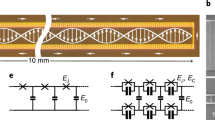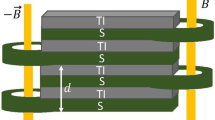Abstract
We study the effects of random \(\pi \) Josephson junctions and applied magnetic field on the quantum phase transitions of superconducting arrays, described by a two-dimensional phase-glass model. The zero-temperature phase diagram and critical behavior are obtained from path-integral Monte Carlo simulations. A superconducting chiral-glass phase occurs for sufficiently large disorder resulting from frustration effects of the \(\pi \) junctions. Unlike the superconductor–insulator transition for weak disorder, the chiral-glass to insulator transition is insensitive to additional frustration introduced by an external magnetic field corresponding to half flux quantum per plaquette. The results are consistent with recent measurements on superconducting thin films with a periodic pattern of nanoholes in an applied magnetic field and doped with magnetic impurities. The magnetic-field frustration effects for the activation energy at low doping and its disappearance at higher doping, observed experimentally, is indicative of a transition to the chiral-glass regime.
Graphic abstract







Similar content being viewed by others
Data Availability Statement
This manuscript has no associated data or the data will not be deposited. [Authors’ comment: All our numerical data have already been presented in the figures.]
References
M.P.A. Fisher, Phys. Rev. Lett. 62, 1415 (1989)
D.A. Huse, H.S. Seung, Phys. Rev. B 42, 1059 (1990)
L. Bulaevskii, V. Kuzii, A. Sobyanin, JETP Lett. 25, 290 (1977)
B.I. Spivak, S.A. Kivelson, Phys. Rev. B 43, 3740 (1991)
M. Sigrist, T.M. Rice, Rev. Mod. Phys. 67, 503 (1995)
H. Kawamura, J. Phys. Soc. Jpn. 64, 711 (1995)
H. Kawamura, M. Li, Phys. Rev. Lett. 78, 1556 (1997)
E. Granato, Phys. Rev. B 69, 012503 (2004)
D. Dalidovich, P. Phillips, Phys. Rev. Lett. 89, 027001 (2002)
P. Phillips, D. Dalidovich, Phys. Rev. B 68, 104427 (2003a)
P. Phillips, D. Dalidovich, Science 302, 243 (2003b)
P.W. Phillips, Nat. Phys. 12, 206 (2016)
H. Jaeger, D. Haviland, B. Orr, A. Goldman, Phys. Rev. B 40, 182 (1989)
D. Das, S. Doniach, Phys. Rev. B 60, 1261 (1999)
C. Christiansen, L. Hernandez, A. Goldman, Phys. Rev. Lett. 88, 037004 (2002)
A. Kapitulnik, S.A. Kivelson, B. Spivak, Rev. Mod. Phys. 91, 011002 (2019)
C. Yang, Y. Liu, Y. Wang, L. Feng, Q. He, J. Sun, Y. Tang, C. Wu, J. Xiong, W. Zhang et al., Science 366, 1505 (2019)
E. Granato, Phys. Rev. B 102, 184503 (2020)
M.D. Stewart Jr., A. Yin, J.M. Xu, J.M. Valles Jr., Science 318, 1273 (2007)
E. Granato, Eur. Phys. J. B 89, 68 (2016a)
E. Granato, Phys. Rev. B 94, 060504(R) (2016b)
X. Zhang, J.C. Joy, C. Wu, J.H. Kim, J. Xu, J.M. Valles Jr., Phys. Rev. Lett. 122, 157002 (2019)
V. Ryazanov, V. Oboznov, A.Y. Rusanov, A. Veretennikov, A.A. Golubov, J. Aarts, Phys. Rev. Lett. 86, 2427 (2001)
R.M. Bradley, S. Doniach, Phys. Rev. B 30, 1138 (1984)
R. Fazio, H. van der Zant, Phys. Rep. 355, 235 (2001)
J. Villain, J. Phys. C. Solid State Phys. 10, 4793 (1977)
H. Kawamura, M. Tanemura, J. Phys. Soc. Jpn. 60, 608 (1991)
E. Granato, Phys. Rev. B 58, 11161 (1998)
J.M. Kosterlitz, N. Akino, Phys. Rev. Lett. 82, 4094 (1999)
E. Granato, Phys. Rev. B 96, 184510 (2017)
E. Granato, J.M. Kosterlitz, Phys. Rev. Lett. 65, 1267 (1990)
M.-C. Cha, S.M. Girvin, Phys. Rev. B 49, 9794 (1994)
S. Sachdev, Quantum Phase Transitions (Cambridge University Press, Cambridge, 2000)
M. Wallin, E.S. Sorensen, S.M. Girvin, A.P. Young, Phys. Rev. B 49, 12115 (1994)
S.L. Sondhi, M. Girvin, J. Carini, D. Sahar, Rev. Mod. Phys. 69, 315 (1997)
K. Hukushima, K. Nemoto, J. Phys. Soc. Jpn. 65, 1604 (1996)
H. Rieger, A.P. Young, Phys. Rev. Lett. 72, 4141 (1994)
L.W. Lee, A.P. Young, Phys. Rev. Lett. 90, 227203 (2003)
H. Nguyen, S. Hollen, J. Shainline, J. Xu, J. Valles, Sci. Rep. 6, 38166 (2016)
E. Granato, Physica B Condens. Matter 536, 442 (2018)
H.G. Ballesteros, A. Cruz, L.A. Fenández, V. Martin-Mayor, J. Pech, J.J. Ruiz-Lorenzo, A. Tarancón, P. Téllez, C.L. Ullod, C. Ungil, Phys. Rev. B 62, 14237 (2000)
R.N. Bhatt, A.P. Young, Phys. Rev. B 37, 5606 (1988)
M.P.A. Fisher, G. Grinstein, S.M. Girvin, Phys. Rev. Lett. 64, 587 (1990)
M.-C. Cha, M.P.A. Fisher, S.M. Girvin, M. Wallin, A.P. Young, Phys. Rev. B 44, 6883 (1991)
Acknowledgements
The author thanks J. M. Valles, Jr. and X. Zhang for helpful discussions. This work was supported by Fundação de Amparo à Pesquisa do Estado de São Paulo-FAPESP (Grant no. 18/19586-9), CNPq (Conselho Nacional de Desenvolvimento Científico e Tecnológico) and computer facilities from CENAPAD-SP.
Author information
Authors and Affiliations
Corresponding author
Appendix
Appendix
Here we describe the results for critical behavior corresponding to the CG-I transition at \(x=0.2\) for \(f=1/2\), obtained from the scaling behavior of the correlation length and phase stiffness. We also obtain an estimate of the electrical conductivity at the transition.
The finite-size correlation length \(\xi \) can be defined as [41]
where S(k) is the Fourier transform of the correlation function C(r) for the relevant order parameter, and \(k_0\) is the smallest nonzero wave vector. The correlation length \(\xi _\tau (L,g) \) in the imaginary-time direction is obtained by the analogous expression. For the phase-coherence transition, the phase correlation length \(\xi _\mathrm{G}\) is obtained from the correlation function defined in terms of the overlap order parameter [37, 42] of phase variables \(q_{\tau ,j}=\exp ( i(\theta ^1_{\tau , j} - \theta ^2_{\tau ,j}) )\), where 1 and 2 label two different copies of the system with the same coupling parameters. Likewise, the chiral correlation length \(\xi ^c_\mathrm{G}\) is obtained in terms of the overlap of the chiral variables defined in Eq. (3), as \(q^c_{\tau ,p}=\chi ^1_{\tau , p} \ \chi ^2_{\tau ,p} \).
For a continuous phase transition, \(\xi (L,g)\) should satisfy the scaling form
where A(x) is a scaling function, \(\delta g = g-g_\mathrm{c}\) and \(\nu \) is the correlation-length critical exponent. It implies that data for \( \xi (L,g)/L \) as a function of g, for different system sizes L, should cross at the critical coupling \(g_\mathrm{c}\). In addition, a scaling plot in the form \(\xi /L \times L^{1/\nu } \delta g\) sufficiently close to \(g_\mathrm{c}\) should collapse the data on to the same curve.
In Fig. 7a, we show the behavior of the correlation length \(\xi _{\mathrm{G},\tau } \) for the phase-glass model with \(f=1/2\) at \(x=0.2\). The dynamic exponent is set to \(z=1.2\), the same value estimated for \(f=0\) since it gives consistent results for the scaling behavior [18]. The curves for \(\xi _{\mathrm{G},\tau }/L \) as a function of g for different system sizes cross approximately at a common point \(g_\mathrm{c}\), providing evidence of a continuous phase-coherence transition. Figure. 7b, shows the scaling plot according to Eq. (9), which gives estimates for \(g_\mathrm{c}\) and \(\nu \).
The corresponding results for the chiral correlation length \(\xi ^c_{\mathrm{G},\tau } \) are shown in Fig. 8. Although the data are much noisier, the behavior is very similar to the phase variables with approximately the same \(\nu \) but a slightly smaller value for \(g_\mathrm{c}\).
The scaling behavior of the phase correlation length \(\xi _{\mathrm{G},\tau }\) in Fig. 7 already indicates that the CG-I transition corresponds to a phase-coherence transition and therefore the chiral-glass phase is expected to be superconducting. To further investigate this property, we consider the scaling behavior of the phase stiffness \(\gamma \), a measure of the free energy cost to impose an infinitesimal phase twist along a given direction. In the imaginary time direction, \(\gamma _\tau \), corresponds to the compressibility of the bosonic system. It is given by [32, 34]
where \(\epsilon _\tau = \sum _{\tau ,i} \cos (\theta _{\tau ,i} -\theta _{\tau +1,i})\) and \(I_\tau = \sum _{\tau ,i}\sin (\theta _{\tau ,i} -\theta _{\tau +1,i})\). In Eq. (10), \(< \ldots>\) represents a MC average for a fixed disorder configuration, and \([ \ldots ]_d\) represents an average over different disorder configurations. In the superconducting phase, \(\gamma \) should be finite, reflecting the existence of phase coherence, while in the insulating phase it should vanish in the thermodynamic limit. For a continuous phase transition, \(\gamma _\tau \) should satisfy the finite-size scaling form [34]
This scaling form implies that data for \( \gamma _\tau L^{2-z} \) as a function of g, for different system sizes L, should cross at the critical coupling \(g_\mathrm{c}\). In Fig. 9, we show the behavior of the phase stiffness in the time direction. Curves for different system sizes cross approximately at the same critical coupling \(g_\mathrm{c}\) estimated from the phase and chiral correlation lengths in Figs. 7 and 8. This behavior lends further support for a superconducting chiral-glass phase for \(f=1/2\), as also observed previously [18] for \(f=0\). From these different estimates, we obtain for the superconducting CG-I transition \(g_\mathrm{c}=1.49(6) \) and \(\nu =1.3(2) \).
Another critical quantity of interest is the value of the electrical conductivity \(\sigma ^*\) at the transition, in units of the quantum of conductance \(\sigma _Q=(2 e)^2/h\). It should be universal [43], but it could depend on the universality class of the transition. The universal conductivity can be determined from the Kubo formula
where \(\gamma (i w_n)\) is the frequency dependent phase stiffness in the spatial direction, evaluated at the finite frequency \(w_n=2 \pi n /L_\tau \), with n an integer. \(\gamma (i w_n)\) in the \({\hat{x}}\) direction is given by
where
and \(\Delta _x \theta _{\tau ,j}= \theta _{\tau ,j}-\theta _{\tau ,j+{\hat{x}}}\). Following the finite-size scaling method of Cha et al. [32, 44], at the transition \(\gamma (i w_n)\) vanishes linearly with frequency and \(\sigma \) assumes a universal value \(\sigma ^*\), which can be extracted from its frequency and finite-size dependence as [32]
The parameter \(\alpha \) is determined from the best data collapse of the frequency-dependent curves for different systems sizes in a plot of \(\frac{\sigma (iw_n)}{\sigma _Q}\) versus \(x_o=(\frac{w_n}{2\pi } - \alpha \frac{2\pi }{w_n L_\tau })\). The universal conductivity is obtained from the intercept of these curves with the line \(x_o=0\). From this scaling behavior, shown in Fig. 10, we obtain \(\sigma ^*/\sigma _Q = 0.53(4)\).
Rights and permissions
About this article
Cite this article
Granato, E. Magnetic-field frustration and chiral-glass to insulator transition in superconducting arrays with random \(\pi \) junctions. Eur. Phys. J. B 94, 143 (2021). https://doi.org/10.1140/epjb/s10051-021-00162-3
Received:
Accepted:
Published:
DOI: https://doi.org/10.1140/epjb/s10051-021-00162-3








